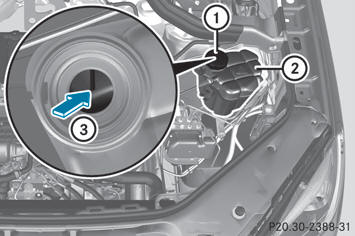Checking the coolant level
Only check the coolant level when the vehicle
is on a level surface and the engine has cooled
down.
Ц Turn the SmartKey to position
2 (Y page 139) in the ignition lock.
On vehicles with KEYLESS-GO, press the
Start/Stop button twice.
Ц Check the coolant temperature gauge in
the multifunction display.
The coolant temperature must be below
158 ∞F (70 ∞C).
 WARNING
WARNING
In order to avoid any potentially serious burns:
- use extreme caution when opening the
hood if there are any signs of steam or
coolant leaking from the cooling system, or
if the coolant temperature display indicates
that the coolant is overheated.
- do not remove the pressure cap on the
coolant reservoir if the coolant temperature
is above 158 ∞F (70 ∞C). Allow the engine to
cool down before removing the cap. The
coolant reservoir contains hot fluid and is
under pressure.
- using a rag, slowly turn the cap
approximately 1/2 turn to relieve excess
pressure. If opened immediately, scalding
hot fluid and steam will be blown out under
pressure.
- do not spill antifreeze on hot engine parts.
Antifreeze contains ethylene glycol which
may burn if it comes into contact with hot
engine parts.

Ц Slowly turn cap 1 half a turn counterclockwise
and allow excess pressure to
escape.
Ц Turn cap 1 further counter-clockwise and
remove it.
If the coolant is at the level of marker bar
3 in the filler neck when cold, there is
enough coolant in coolant expansion
tank 2.
If the coolant is approximately 0.6 in
(1.5 cm) above marker bar 3 in the filler
neck when warm, there is enough coolant
in coolant expansion tank 2.
Ц If necessary, add coolant that has been
tested and approved by Mercedes-Benz.
Ц Replace cap 1 and turn it clockwise as far
as it will go.
See also:
Introduction to destination entry
WARNING
For safety reasons, only enter a new
destination when the vehicle is stationary.
You could otherwise be distracted from the
traffic conditions, cause an accident and
injure yoursel ...
Transmission positions
Park position
Do not shift the transmission into
position P unless the vehicle is
stationary. The parking lock should
not be used as a brake when
parking. In addition to engaging the
parki ...
Multicontour seat
Information about the components and
operating principles of COMAND can be
found on.
The contour of the driver's seat and frontpassenger
seat backrests can be individually
adjusted to provid ...
